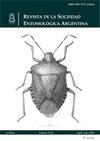Economic assessment of entomophilous pollination in crops from Argentina: possible effects of the pollinator crisis in agriculture
IF 0.5
4区 农林科学
Q4 ENTOMOLOGY
引用次数: 1
Abstract
In Argentina, food production is the basis of economic and social development. Several crops depend on entomophilous pollination. However, wild and managed pollinators are threatened by conventional agricultural management practices. In this work, we evaluate the economic value attributed to entomophilous pollination (EEV) of the main crops between 2013 and 2018. Our study focused on analyses of crops with varying degrees of pollinator dependence in terms, their harvested area, yield and total economic value (EV). The EEV attributed to pollinators and the vulnerability of each crop category were estimated. The EEV attributed exclusively to entomophilous pollination, in the 27 crops analyzed, was US$ 4.437 million, representing a contribution of the pollinators of 21,83% of the EV and 13,8 million tons of agricultural products. The EEV in decreasing order is industrial crops, fruit trees, vegetables, nuts and citrus. In industrial crops, where managed pollinators are not used, the contribution of pollinators was high, reaching US$3.655 million. Fruit trees and vegetables are the most vulnerable to an eventual decrease or absence of pollinators with estimated vulnerability rates of 68 and 38% respectively. These results show the economic contribution of the pollinators to the country's agriculture, the high vulnerability of agroecosystems and the effects in quantitative terms of a potential reduction in food production due to a pollination deficit. Finally, this work may be useful to guide decision-making and establish public policies aimed at promoting diversification and sustainability of agricultural models to guarantee food security.阿根廷作物昆虫授粉的经济评估:传粉者危机对农业的可能影响
在阿根廷,粮食生产是经济和社会发展的基础。有几种作物依靠昆虫授粉。然而,野生和人工传粉媒介受到传统农业管理做法的威胁。在这项工作中,我们评估了2013年至2018年间主要作物的昆虫授粉(EEV)的经济价值。本研究着重分析了不同程度传粉媒介依赖性作物的收获面积、产量和总经济价值。估计了传粉媒介的EEV和各作物类别的脆弱性。在分析的27种作物中,完全归因于昆虫授粉的EEV为443.7万美元,代表传粉媒介对EV的21.83%和农产品的1380万吨的贡献。从低到低依次是工业作物、果树、蔬菜、坚果和柑橘。在不使用管理传粉媒介的工业作物中,传粉媒介的贡献很高,达到365.5万美元。果树和蔬菜最容易受到传粉媒介减少或缺乏的影响,估计脆弱性分别为68%和38%。这些结果显示了传粉媒介对该国农业的经济贡献、农业生态系统的高度脆弱性以及由于授粉不足而可能导致粮食产量减少的定量影响。最后,这项工作可能有助于指导决策和制定旨在促进农业模式多样化和可持续性的公共政策,以保障粮食安全。
本文章由计算机程序翻译,如有差异,请以英文原文为准。
求助全文
约1分钟内获得全文
求助全文
来源期刊

Revista De La Sociedad Entomologica Argentina
Agricultural and Biological Sciences-Insect Science
CiteScore
0.80
自引率
20.00%
发文量
31
审稿时长
20 weeks
 求助内容:
求助内容: 应助结果提醒方式:
应助结果提醒方式:


